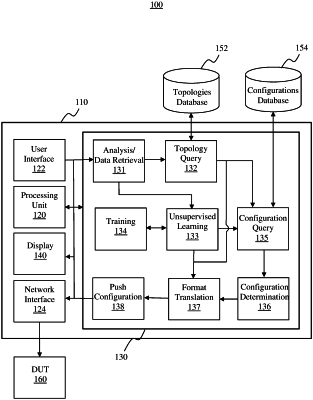| CPC H04L 41/0816 (2013.01) [G06N 3/04 (2013.01); H04L 41/0866 (2013.01); H04L 41/0886 (2013.01); H04L 41/12 (2013.01)] | 20 Claims |

|
1. A system for configuring network elements in a design network topology, the system comprising:
a topologies database for storing a plurality of previously determined network topologies;
a configurations database for storing previously determined configurations of the network elements in the previously determined network topologies, respectively;
a processing unit; and
a non-transitory memory for storing instructions that, when executed by the processing unit, cause the processing unit to:
receive an image of a design network topology comprising a plurality of network elements, wherein the design network topology provides at least one of structural or logical arrangements of the plurality of network elements in a communication network;
attempt to retrieve design data from the received image corresponding to the design network topology using a constellation-based model and using a supervised machine learning algorithm when the design data cannot be retrieved using the constellation-based model, depending on a format of the received image;
when the design data can be retrieved, query the topologies database using the design data to find a previously determined network topology that substantially matches the design network topology, and identify configurations for network elements in the matching network topology in the configurations database;
when the design data cannot be retrieved, predict a network topology using an unsupervised machine learning algorithm, and identify configurations for network elements in the predicted network topology in the configurations database;
determine design configurations for the network elements of the design network topology from the identified configurations;
translate the design configurations of the network elements to a standard format; and
push the translated design configurations to at least one of actual network elements or virtual network elements corresponding to the network elements.
|